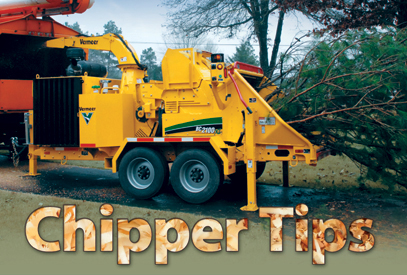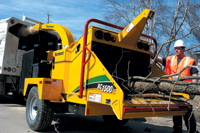Chipper Tips

Wood chippers are serious workers, which means time and consideration are needed to find a quality grinder that can handle the rigors of turning trees and brush into chips and dust. Before a new purchase, it’s imperative that contractors quiz their crews with the right buying questions so they can purchase a brush chipper that’s a good fit in terms of size, towing, performance and how they intend to dispose of the resulting wood debris.
“Customers who are looking to purchase their first brush chipper or who are getting into the industry, should consider what type of business they’re going to be doing,” says Todd Roorda, environmental solutions specialist for Vermeer in Pella, Iowa. “Are they going to be doing mostly tree trimming or are they going to be getting into takedowns? Those are two completely different arenas which may require different brush chipper sizes and features.”
Big Chipper or Small Chipper?
A contractor looking to specialize in tree trimming should consider a smaller brush chipper first. Contractors performing land-clearing work involving tree takedowns will generally need a larger unit.
Roorda says a good rule of thumb is to purchase a chipper that can effectively handle a minimum of 80 to 90 percent of the tree and brush a contractor intends to chip. For example, if a tree service provider plans to process trees where the bulk of the material is 12 to 18 in. in diameter, then an 18-in. capacity brush chipper would be more than sufficient, whereas not all of the material from that tree would be able to go through a 12-in. chipper.
Not only should contractors evaluate the tree material that they’ll be chipping, but they must also take a close look at their work environment. Will they be working in confined residential areas with smaller trees or in green areas with large, mature trees? In either case, there are definite disadvantages if contractors choose a brush chipper that’s either too small or too large for the jobs they’ll tackle.
“If the chipper is too small, they’re going to spend a lot more time maneuvering and handling the material,” Roorda says. “They’ll spend time hauling wood off to other companies’ sites so that it can be chipped and prepared for dumping.” Because most dumpsites no longer accept whole trees and large logs, a contractor with a brush chipper that’s too small will likely incur higher tipping fees.
Roorda says contractors can also expect additional costs by opting for a brush chipper that’s larger than needed. “If a machine is too large for a contractor, he or she may have to get a larger truck and there probably will be additional fuel costs associated with not only the truck, but also the chipper,” he says. “Larger chippers have more horsepower and more horsepower takes more fuel.
“If you have an 18- or 21-in. capacity brush chipper and you’re only chipping 6-in. material, you’re using more fuel to run a chipper that’s larger than required by the material being chipped,” he adds.
When it comes to transporting a brush chipper, contractors should consider the size of the towing vehicle and the types of areas they’ll be working in. Tree service providers working in mostly residential areas more than likely won’t want a large truck and chipper that will be difficult to maneuver in driveways and down narrow streets or cul-de-sacs. In contrast, a contractor specializing in land clearing will prefer a truck and chipper that can go off-road and easily travel across difficult terrain.
As customers decide on a chipper, they should also consider the type of cutting mechanism — drum or disc. While they are distinctly different in productivity and design, each has its advantages when applied correctly.

“With fuel prices going the way they are, customers are giving more consideration to the weight of chippers that they’ll be pulling behind their truck,” Roorda says.
When deciding between a drum and disc chipper, contractors must also consider how they plan to use the resulting product — will it be used for mulch, compost or as an alternative energy source? Because drum and disc machines cut wood differently, Roorda says the resulting chips will also look different. “One doesn’t necessarily give you a more consistent chip over the other. It’s merely a difference of cutting technique,” he says.
Productivity and Safety Weigh In
“A nice complement to adequate horsepower is proper use of that power,” Roorda says. For example, Vermeer brush chippers feature what’s called a SmartFeed system, which constantly monitors the machine’s engine rpm and feed rollers. The system allows the chipper to automatically start and stop the feed rollers based on engine loading resistance. It also automatically reverses the rollers or “massages the wood” when a jam occurs.
Chipper knives are another major component that can affect brush chipper productivity. Dull chipper knives can contribute to accelerated wear and tear of the machine. Instead of cutting the wood, dull chipper knives essentially beat the logs and branches, causing increased vibration and strain on the machine. “So the sharper the chipper knives stay, the more efficient the overall machine is … you won’t just have improved chip quality,” Roorda says.
Recently, manufacturers have begun seeking new and innovative ways to increase their machines’ productivity. One new feature being offered on larger brush chippers is a radio remote control. Because these brush chippers are mainly used for site preparation and land clearing, the remote control enables a worker to operate the brush chipper from the cab of the loader being used to feed the chipper.
It can be argued that brush chipper safety features are becoming more important than size and performance. “Innovative and effective safety features combined with safe work practices are important for every ground worker feeding the machine,” Roorda says.
Longer feed tables provide more distance between the cutters and operators. New innovative improvements now include an enhanced upper feed control bar having an additional emergency stop position, and the patented Bottom Feed Stop Bar at the front of the feed table can be operated by the worker’s leg in an emergency situation.
Debris Disposal Options
There’s no question that contractors have a lot to consider when purchasing a brush chipper, from size and towing requirements to productivity and safety features. Another question that contractors must ask themselves is what they will do with the resulting wood debris.
Over the years, Roorda says the demand for wood chips has grown because they are being used for a variety of recycling purposes, including mulch, compost and alternative energy. “Depending on what you have access to in your area, there’s a growing market for the resulting product. You don’t have to just dump it anymore,” he says.
Partnering with a company in need of wood chips may also help contractors reduce their operating costs by reducing or eliminating tipping fees. With energy costs continually rising, people and companies have focused attention on finding alternative ways to produce energy and many have turned to wood waste. Because of this, some energy plants and industrial companies will pay to obtain wood chips from tree service companies. However, most of these companies have specific size restrictions on the wood chips that they’ll accept.
“Chip sizing is becoming a greater concern for customers because in certain applications, they can only deal with a certain size of chip,” Roorda says.
In addition to energy plants and industrial companies, those in the mulch business may also pay arborists for their wood chips. Roorda suggests that contractors check with their local waste authorities because an increasing number of these operations are adding composting to their list of services. Although most waste facilities charge a tipping fee, this can provide a cost-effective option to dispose of wood chips, especially if the facility is nearby.
In the end, a contractor’s ultimate goal should be to purchase a brush chipper that adds value to their business. But before sitting down and signing the purchase agreement on a specific model, there are many questions that must be answered. Roorda says the best advice he can give contractors is to seek the help of a knowledgeable dealer sales staff and dependable service department to identify a reputable manufacturer with quality products.
“They’ll help you in making a decision that’s right for your company,” he says.
Tara Deering-Hansen is a technical writer for Two Rivers Marketing, based in Des Moines, Iowa.
All That and a Bag of ChipsNothing makes stomachs drop and contractors turn pale more than not being able to mobilize a new brush devouring monstrosity. When your chipper investment will run between $4,000 for a 4.5-in. to $65,000 for a 20-in. chipper ($25,000 to $40,000 for a 12- to 15-in. chipper), you want to make sure that you get the most chip for your buck. And you’re primed to let loose of your latest technological terror upon unsuspecting wooden debris. Perfecting the technologies of brute force, manufacturers such as Vermeer, Rayco, ECHO, Bear Cat, Morbark and Bandit have fine tuned the “chuck and duck” chippers of old into precise brush cutting machines that are safe and productive. Today’s brush chippers can handle material diameters ranging from 4.5 to 20 in. and offer a variety of safety features (from easily-activated stopping mechanisms to auto-feeding). When stepping onto the dealer’s lot with hopes of taking home your very own chipper, you need to match the machine to your job demands. Brush chipper capacity is rated by the size of the feed opening. There are commonly 4.5-, 6-, 12-, 15-, 18- and 20-in. chippers. The smaller 6-in. chippers are mostly used by homeowners and landscapers, the 12-in. chippers are used by tree services and tree contractors and the 18- and 20-in. chippers you see more on site prep and land-clearing jobs. The choice of chipper is absolutely relative to the job. You need to have an understanding of the material you’ll be working with. |

Comments are closed here.